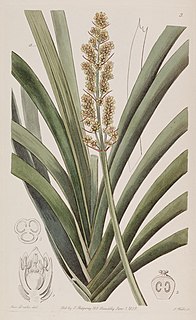
Lomatia tasmanica, commonly known as King's lomatia, is a shrub of the family Proteaceae native to Tasmania. Growing up to 8 metres (26 ft) tall, the plant has shiny green pinnate (lobed) leaves and bears red flowers in the summer, but yields neither fruit nor seeds. King's lomatia is unusual because all of the remaining plants are genetically identical clones. Because it has three sets of chromosomes and is therefore sterile, reproduction occurs only vegetatively: when a branch falls, that branch grows new roots, establishing a new plant that is genetically identical to its parent.

Darwinia, sometimes commonly known as mountain bells or simply bells, is a genus of about 70 species of evergreen shrubs in the family Myrtaceae, endemic to southeastern and southwestern Australia. The majority are native to southern Western Australia, but a few species occur in South Australia, New South Wales and Victoria. The genus was named in honour of Erasmus Darwin, grandfather of Charles Darwin by Edward Rudge in 1816. Most darwinias grow to a height of between 0.2 and 3 m, and many are prostrate shrubs. Most have small, simple leaves and the flowers are often grouped together, each flower with five red, white or greenish petals and ten stamens. In many species, the flowers are surrounded by large, colourful bracts, giving rise to their common names.

Arthropodium is a genus of herbaceous perennial plants in the subfamily Lomandroideae of the family Asparagaceae. It is native to Australia, New Zealand, New Caledonia and Madagascar.
Botanical nomenclature is the formal, scientific naming of plants. It is related to, but distinct from taxonomy. Plant taxonomy is concerned with grouping and classifying plants; botanical nomenclature then provides names for the results of this process. The starting point for modern botanical nomenclature is Linnaeus' Species Plantarum of 1753. Botanical nomenclature is governed by the International Code of Nomenclature for algae, fungi, and plants (ICN), which replaces the International Code of Botanical Nomenclature (ICBN). Fossil plants are also covered by the code of nomenclature.

Lomandra, commonly known as mat rushes, is a genus of perennial, herbaceous monocots in the family Asparagaceae, subfamily Lomandroideae. There are 51 species, all of which are native to Australia; two of them also extend into New Guinea and New Caledonia.

Asparagaceae, known as the asparagus family, is a family of flowering plants, placed in the order Asparagales of the monocots. One member of the family is Asparagus officinalis, the garden asparagus.

Banksia acanthopoda is a species of shrub in the family Proteaceae. It grows as a small spreading shrub to 2 m high and has prickly leaves and yellow composite flower heads, called inflorescences, composed of 50 to 60 individual yellow flowers. Flowering takes place in the southern hemisphere winter. Endemic to Western Australia, it occurs only in a few populations in the vicinities of Woodanilling, Katanning and Darkan. Because of its rarity, it is classed as "Priority Two" conservation flora by Western Australia's Department of Environment and Conservation.

Banksia squarrosa, commonly known as pingle, is a species of prickly shrub that is endemic to Western Australia. It has linear to narrow lance-shaped leaves with up to ten sharply-pointed teeth on each side, yellow flowers in heads of about sixty and later, up to seven oblong to egg-shaped follicles in each head.

Thysanotus is a genus of perennial herbs in the family Asparagaceae, subfamily Lomandroideae. They are mostly native to Australia with 45 of the 50 known species occurring in Western Australia alone, although a few species range northward into New Guinea and Southeast Asia as far north as southern China.

Acanthocarpus is a genus in the family Asparagaceae, subfamily Lomandroideae, in the APG III system of classification. It has been difficult to place at family rank, being placed at various times in Dasypogonaceae as well as the Asparagaceae. The entire genus is endemic to the State of Western Australia.

Eustrephus is a monotypic genus in the family Asparagaceae, subfamily Lomandroideae.
Banksia squarrosa subsp. squarrosa is a subspecies of Banksia squarrosa, commonly called "pingle". As an autonym, it is defined as encompassing the type material of the species. It was known as Dryandra squarrosa subsp. squarrosa until 2007, when Austin Mast and Kevin Thiele sunk all Dryandra into Banksia. As with other members of Banksia ser. Dryandra, it is endemic to the South West Botanical Province of Western Australia.

Chamaescilla is a genus of Australian herbs in the subfamily Hemerocallidoideae within the asphodel family. They have grass-like basal leaves and tuberous roots. The flowers have six petals and six stamens. The seed capsules contain black, glossy seeds.

Dichopogon is a genus of perennial herbs, native to Australia and New Guinea. It is included in the genus Arthropodium by some authorities, although recognized as a distinct genus by others. In the APG III classification system, it is placed in the family Asparagaceae, subfamily Lomandroideae.

Laxmannia is a genus of tufted perennial herbs in the family Asparagaceae, subfamily Lomandroideae, that are endemic to Australia.
Murchisonia was a genus of perennial herbs in the family Asparagaceae, subfamily Lomandroideae.

Xerolirion is a monotypic genus of perennial herbs in the family Asparagaceae, subfamily Lomandroideae. The only known species is Xerolirion divaricata, commonly known as Basil's asparagus, from Western Australia.

Melaleuca squarrosa, commonly known as scented paperbark, is a plant in the myrtle family, Myrtaceae and is endemic to south eastern parts of Australia, especially Tasmania. It is an attractive shrub with dense foliage and arching branches and it flowers profusely in spring or early summer, bearing spikes of perfumed yellow to white flowers.

Darwinia squarrosa, commonly known as the fringed mountain bell or pink mountain bell, is a shrub that is endemic to the south-west of Western Australia.
Hibbertia squarrosa is a species of flowering plant in the family Dilleniaceae and is endemic to the west of Western Australia. It is an erect shrub with linear leaves and yellow flowers with twenty stamens arranged around five glabrous carpels.
















